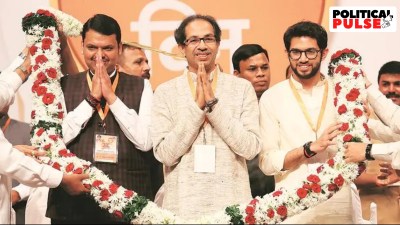- India
- International
Emails in new book open a window to psyche of terrorist David Headley
The book does not reveal the identities of the recipients of the emails but reveals that 55 days after the Mumbai attacks, Headley was sent to Copenhagen to conduct reconnaissance for the strike.
 Sorensen’s narrative draws from over 300 previously unpublished emails and private letters written by Headley, secret audio records and electronic wiretapping transcripts.
Sorensen’s narrative draws from over 300 previously unpublished emails and private letters written by Headley, secret audio records and electronic wiretapping transcripts.
In a top-secret prison “somewhere in the US”, serving his sentence till 2039, he is now back to being a devout Muslim, learning the Quran and signing his name as “Daood”.
David Headley may have escaped the death penalty and extradition to India but a forthcoming book titled The Mind of a Terrorist by Danish journalist Kaare Sorensen — English translation by Penguin — provides a rare insight into Headley’s psyche, his links to Lashkar-e-Toiba and al-Qaeda, and his activities leading up to the 26/11 Mumbai attacks in which 166 people were killed.
Sorensen’s narrative draws from over 300 previously unpublished emails and private letters written by Headley, secret audio records and electronic wiretapping transcripts. For instance, it reveals the contents of an email that Headley wrote after 26/11, referring to what Ajmal Kasab could have told Indian interrogators. Kasab was hanged on November 21, 2012, at Pune’s Yerawada jail for his role in the attacks.
[related-post]
Watch Video: What’s making news
“There is no need to ‘sing’ as the song would already be known to the relevant agency. So my prediction is that Pakistan will never turn over anyone to India, and the US — looking at the ‘larger picture’ — will not put too much pressure either. This thing will slowly just go away, till of course Bharat Mata is embarrassed again.”
Sorensen also describes how after 26/11, Headley and Lashkar commander Sajjid Mir held several meetings in the former’s Lahore home and picked the Danish newspaper Jyllands-Posten as the next target in retaliation for its controversial cartoons. At the time, Headley wrote in an email : “A world wide mechanism needs to be developed in which Justice can be given to all. The worst is yet to come…this fight has just begun.”

The book does not reveal the identities of the recipients of the emails but reveals that 55 days after the Mumbai attacks, Headley was sent to Copenhagen to conduct reconnaissance for the strike.
While Headley identified Mir and Hafiz Sayeed, the chief of Jama’at-ud-Da’wah, labelled as a terror organisation by the UN, as his key Pakistani contacts during his video interrogation this February, the book reveals his association with Ilyas Kashmiri, the one-eyed commander of another terror outfit Brigade 313, whom Headley met for the first time in February 2009, in Miranshah in North Waziristan.
By this time, Headley was worried about the Lashkar not being able to pull off the logistics for the Denmark attacks. The author notes: “Kashmiri made it very clear that Headley needn’t wait for his friends from Lashkar if they didn’t have the manpower for an attack on Denmark. Kashmiri would provide the necessary men, funds and weapons if Headley would just deliver a fully prepared plan. The attack on Denmark was a mission for Brigade 313. A mission for al-Qaeda…”
Headley held a second meeting with Kashmiri in Miranshah — “the house was filled with suicide vests for an operation” — and was instructed that the ‘Jyllands-Posten’ attack should be gruesome and that the heads of its employees be severed. Headley was told that “elders” of the al-Qaeda, among them Osama bin Laden, had approved of this method in a secret meeting.
However, the book reveals, a parallel plan to mount a second suicide attack in India was also afoot. It says Headley returned to India 100 days after 26/11, and surveyed destinations frequented by Israelis in Delhi and Goa. In all, he identified 34 fresh “potential targets” in India, the book says.
But on October 3, 2009, Headley was arrested after he landed in Philadelphia airport from Copenhagen and onward to meet Mir and Kashmiri in Pakistan. His arrest, the author writes, “was described by FBI Director, Robert Muller, as the most significant revelation of terrorism-related intelligence the American government received in at least half a year…The information was so crucial that in a short time it had been sent directly to the White House and likely also to President Barack Obama personally.”
The book also reveals how US authorities had been on the tail of Headley, first in his avatar as a drug peddler and then as drug enforcement agent Daood Gilani. He was detained at US airports six times, the last being in August 2009, two months prior to his arrest.
According to Sorensen, Headley was first detained at Frankfurt airport in 1988 with a consignment of heroin. Once he divulged details about the cartel, it was the beginning of a long-term job as an agent for the American narcotics department, the book claims.
Headley came out on parole in 15 months, and went to Pakistan where he continued to help American authorities with heroin hauls. Around this time, he came in touch with Sayeed and gave himself up unconditionally to Islam, the book says. Following the September 11, 2001 attack, the book says, Headley spurned feelers from US drug enforcement officers and joined his first arms training camp in Pakistan.
Headley’s next brush with the law was in October 2001 when a bartender complained to FBI about his suspected terror links, the book says. But when questioned, Headley allegedly told officers he had no interest in Pakistan and the case was closed.
In 2002, his mother’s friend raised an alarm over Headley attending training camps but the FBI conducted a cursory character check, says the book.
A third complaint was made, the book says, this time in August 2005, by Headley’s Canadian wife who offered to help the US Joint Terrorism Task Force with evidence. This time, Headley’s details were added to a database with the noting: “no connection to terrorism”.
But it was another of Headley’s wives, a Moroccan named Faiza Outalha who came the closest to nailing him, says the book. In December 2007, she visited the American Embassy in Pakistan to reveal that Headley was planning “jihad” and had attended arms training at Lashkar camps. She even handed over photos of herself with Headley in front of the Taj Hotel in Mumbai.
Sorensen writes: “The information about Headley and a possible attack in Mumbai was never passed on from the American Embassy to Indian authorities. Later, the Americans did give India a weak warning about a possibly approaching attack but it didn’t include the name David Headley.”
Eventually, the decision to detain Headley in Philadelphia was taken at the “highest levels”, the book claims. The
author reveals: “Headley named specific targets that the American and Indian governments weren’t aware of, and was able to point out specific weaknesses in the American government’s surveillance of terrorists…Headley also revealed details that are still classified, which the American government will likely keep secret forever…”
The book contains other nuggets on the Mumbai attacks:
* In September 2006, Headley purchased backpacks in Mumbai which Kasab and nine other terrorists used on 26/11.
* Prior to the attack, Mir and associates had built a styrofoam model of the Taj Hotel to train the attackers.
* In “preliminary discussions”, a getaway plan for the attackers was debated, which included hijacking a train or bus and taking it to Kashmir.
* Headley, who will be 79 years old when he walks out of prison, had also contemplated ransacking a diamond store at the Taj Hotel while the attack was on to finance future terror attacks.
Apr 20: Latest News
- 01
- 02
- 03
- 04
- 05







































